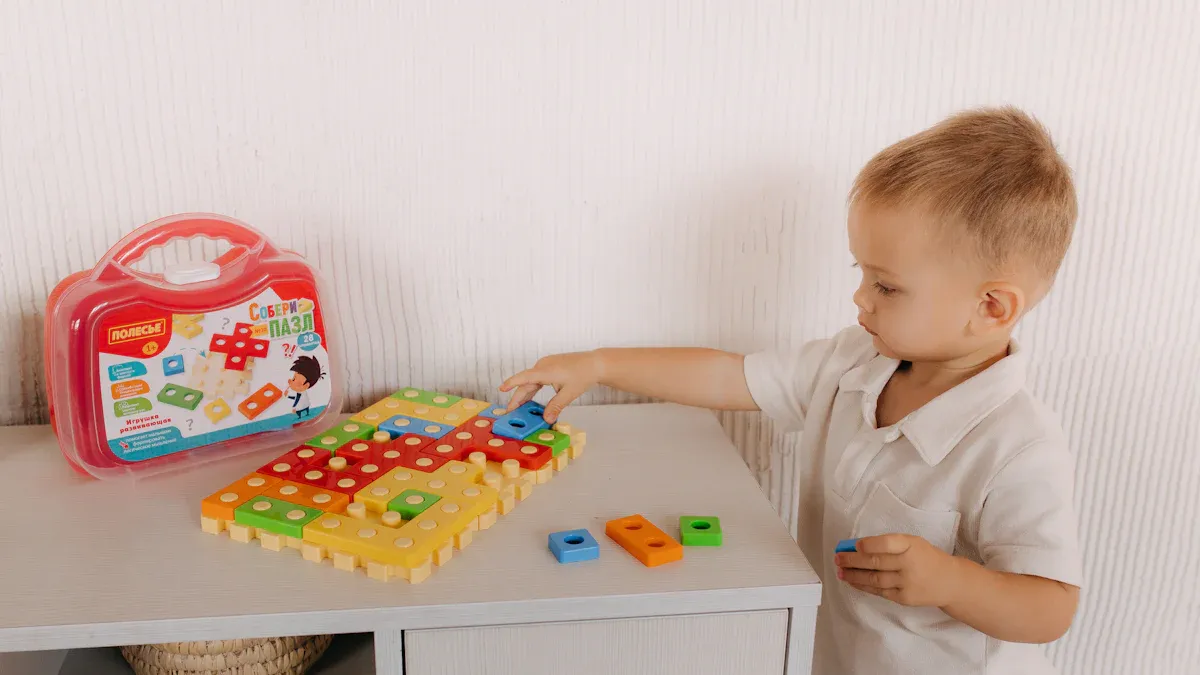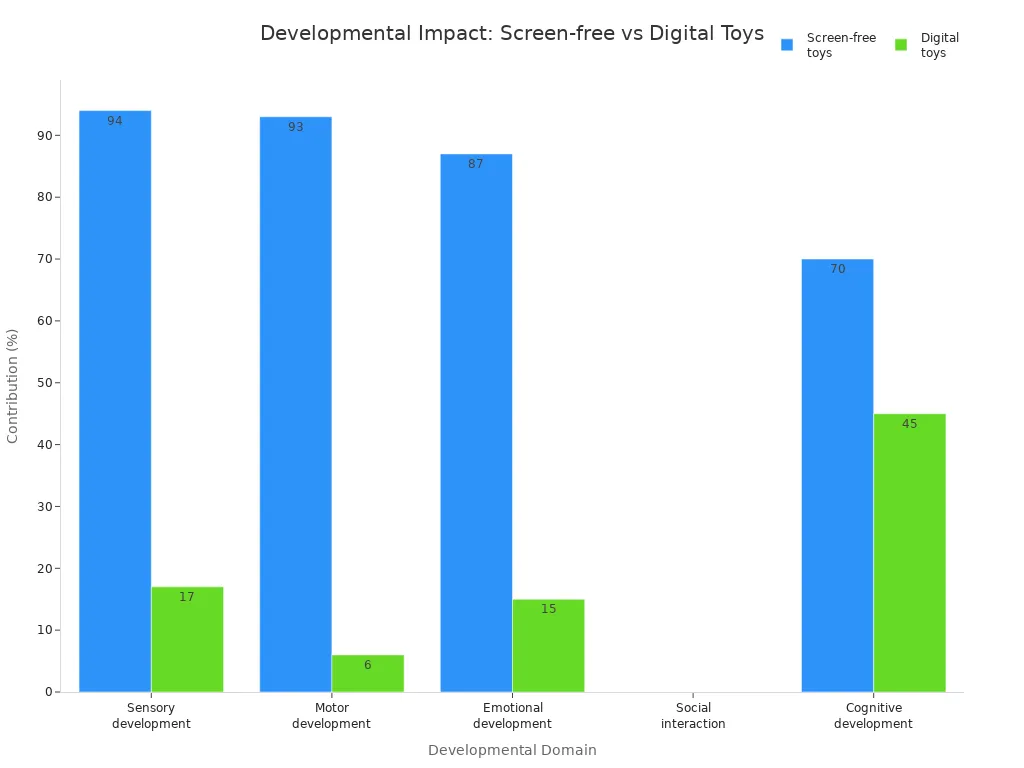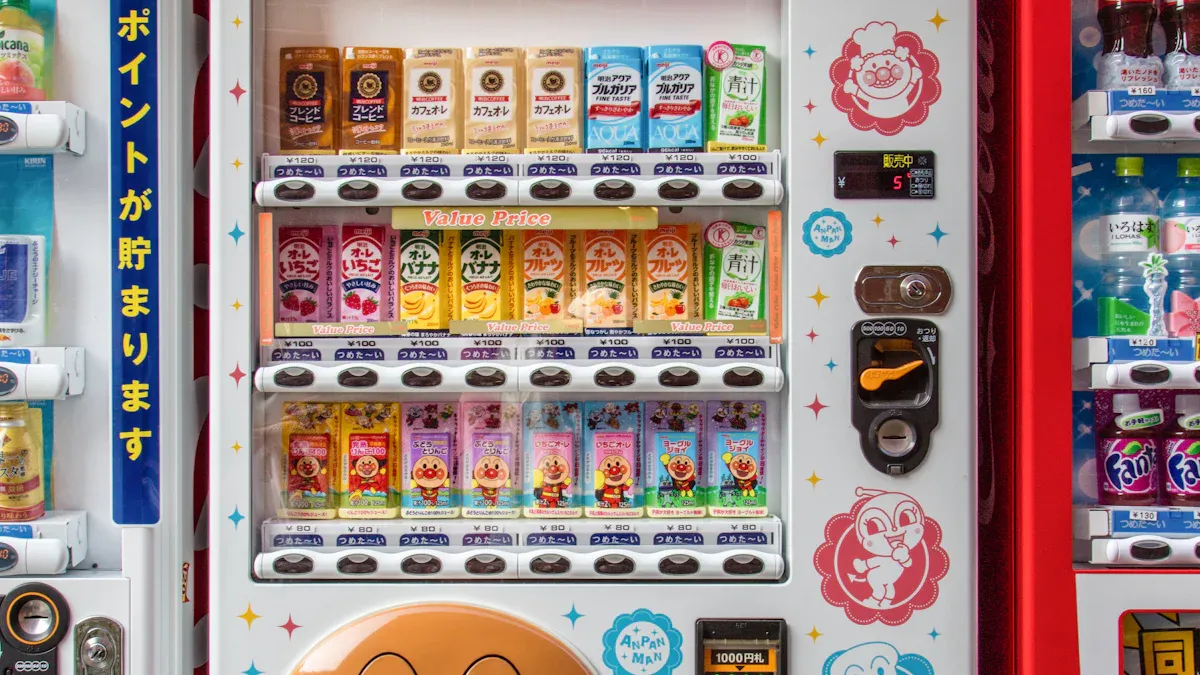Interactive Learning with the Melissa & Doug Snacks to Go Vending Machine for parents

Ever wonder how you can make playtime both educational and fun? You are not alone—over 80% of parents say educational value matters when choosing toys for their kids.
Statistic Description | Percentage |
|---|---|
Parents who believe educational toys are crucial | ~80% |
Households with children under 10 owning at least one educational toy | 82.7% |
Parents who give their children educational toys | 83% |
The Melissa & Doug Snacks to Go Vending Machine brings interactive learning right into your home. This wooden vending machine, a three-time preschool toy of the year, stands out with its hands-on sorting, color-matching coins, and working buttons. Kids press, drop, and collect snacks, creating real-world vending moments. You will love how this toy inspires hands-on learning fun and keeps screens out of playtime. The chart below shows why screen-free toys like this wooden vending machine encourage better sensory, motor, and social skills than digital options:

With the preschool toy of the year, you can turn every snack into an adventure in interactive learning. Ready to see your child enjoy hands-on fun with their favorite vending snacks?
Key Takeaways
The vending machine toy helps children learn colors, numbers, and cause-and-effect through hands-on play.
Playing with others builds social skills like sharing, communication, and teamwork.
Using the toy strengthens fine motor skills by practicing finger movements and hand-eye coordination.
Parents can guide play with simple games or let kids explore independently to boost creativity and confidence.
Changing snacks and involving the family keeps playtime fun and supports learning in many ways.
Interactive Learning Benefits

Cognitive Skills
You want your child to learn while having fun. The Melissa & Doug Snacks to Go Vending Machine makes this possible by turning every moment into an interactive learning adventure. When your child sorts snacks, matches coins, and presses buttons, they build important cognitive skills. The toy supports letter, number, and color recognition. Each time your child matches a blue coin to a blue button or counts snacks, they practice early math and sorting.
Research shows that hands-on toys like this vending machine help children remember what they learn. The bright colors and different shapes boost pattern recognition and problem-solving. When your child drops a coin and sees a snack pop out, they learn about cause and effect. This process helps them connect actions with results, which is key for problem-solving and logical thinking.
Tip: Encourage your child to name the colors and numbers as they play. This simple step builds vocabulary and confidence.
Pretend play with the vending machine also sparks imagination. Your child can act as a shopkeeper or a customer, using language and storytelling. These activities help them practice new words and ideas. Studies show that early math play, like counting snacks or sorting coins, leads to better academic skills later in life. The vending machine makes learning these concepts feel like a game, not a lesson.
Social Skills
Interactive learning goes beyond solo play. When your child shares the vending machine with friends or siblings, they learn how to take turns and cooperate. Pretend play encourages teamwork and communication. Your child might ask, “What snack would you like?” or “Can I have a turn?” These simple questions build social skills and help children understand how to interact with others.
Role-playing as a shopkeeper or customer gives your child a chance to practice real-life conversations. They learn how to listen, respond, and use polite words. This kind of play supports language development and helps children feel comfortable in social settings. When kids work together to stock the vending machine or count coins, they practice negotiation and problem-solving as a team.
Note: Invite your child to play with a friend or family member. Watch how their language and social skills grow with each pretend shopping trip.
Fine Motor Skills
The vending machine is more than just a fun toy—it is a tool for building fine motor skills. Your child uses their fingers to pick up coins, press buttons, and open the snack drawer. These actions require careful hand movements and coordination. Stocking the vending machine with snacks or inserting coins helps strengthen the small muscles in their hands.
Children develop these skills naturally as they play. The toy’s design encourages repeated practice, which leads to better control and precision. Fine motor development is important for tasks like writing, drawing, and using scissors later on.
Activity | Fine Motor Benefit |
|---|---|
Inserting coins | Improves finger strength |
Pressing buttons | Builds hand-eye coordination |
Stocking snack packages | Enhances grip and dexterity |
Opening and closing the drawer | Refines wrist and finger control |
You will notice your child’s confidence grow as they master these tasks. The vending machine offers a playful way to support important milestones in development.
Toy Play Ideas

Guided Play
You can turn the vending machine toy into a fun learning tool with a little guidance. Try setting up a simple game where your child matches coins to the correct snack slot. Give step-by-step instructions, like “Find the red coin and put it in the red slot.” This helps children practice color recognition and following directions. You might also create a pretend store. Take turns being the shopkeeper and the customer. Ask questions like, “How much does this snack cost?” or “Can you give me two coins?” These guided play experiences build early math and language skills while keeping playtime exciting.
Tip: Use the toy as a reward station. When your child shows kindness or responsibility, let them earn a coin to use in the vending machine. Behavioral studies show that this system motivates positive behavior and makes learning routines more engaging.
Independent Play
Let your child explore the toy on their own. Watch as they invent new games, sort snacks, or create stories about their favorite treats. Independent play encourages creativity and problem-solving. You might notice your child lining up the snacks by color or counting how many fit in the drawer. This self-directed play helps children build confidence and discover new ways to use the toy. The vending machine can even become a special place for them to “buy” a snack after finishing homework or chores, reinforcing good habits.
Family Play
Bring everyone together for a family play session. Set up a snack shop and let each person take a turn choosing and “buying” a treat. You can make it a game by giving out coins for helping with dinner or showing teamwork. Family play builds social skills and creates lasting memories. Some families use the toy as a reward system, where coins are earned for positive actions and exchanged for snacks or small prizes. This approach, supported by behavioral research, helps reinforce good behavior and keeps everyone involved.
Play Scenario | Skill Focus | Fun Twist |
|---|---|---|
Guided Snack Shop | Math, Language | Use silly voices |
Solo Snack Sorting | Creativity, Counting | Make up snack stories |
Family Reward Night | Teamwork, Sharing | Winner picks dessert |
Pretend Food Play Tips
Customizing by Age
You can make pretend food play work for any age. Younger kids love sorting play food pieces by color or shape. Ask them to match coins to the right snack slot. This simple game helps them learn colors and counting. For preschoolers, you can introduce basic money ideas. Let them use color-matching coins or a bank card to “buy” snacks. They insert coins and press buttons, just like a real vending machine. Older children enjoy keeping track of snacks with the activity card or sign. You can challenge them to manage the vending machine’s stock or set prices for each snack. This builds early math and decision-making skills.
Tip: Adjust the difficulty by changing the rules. For example, ask younger kids to sort snacks, while older kids can count coins or make change.
Age Group | Activity Idea | Skill Focus |
|---|---|---|
Toddlers | Sorting snacks by color | Color recognition |
Preschoolers | Buying snacks with coins | Counting, money |
Early Grades | Managing stock and prices | Math, decision-making |
Real-Life Lessons
You can use kitchen play sets and vending toys to teach important life skills. When your child “buys” snacks, they learn about money exchange and value. They practice matching, sorting, and counting coins. This hands-on play helps them understand how money works in everyday life. You can talk about healthy choices while playing. Pretend food play lets you teach your child about nutrition and balanced meals. Ask questions like, “Which snack is the healthiest?” or “Why do we need fruits and veggies?” Playing with pretend food toys helps kids build healthy eating habits. It also supports imagination, language, and social skills.
Pretend food play gives your child a fun way to explore food concepts.
Play food pieces help children learn about different foods and cultures.
Kitchen play sets encourage kids to make choices and solve problems.
Note: Use pretend play to start conversations about nutrition, money, and making good decisions. Your child learns best when play feels like an adventure.
Playtime Solutions
Overcoming Challenges
Every family faces bumps during playtime. Sometimes, kids get frustrated if the vending machine jams or if they have to wait for a turn. Sibling rivalry can pop up, too. You can handle these moments with a few simple strategies:
Try the "Green to Red Light" approach. If you hear minor bickering, let kids work it out. If tension rises, step in and acknowledge their feelings. For serious conflicts, pause play and review the rules together. If things get unsafe, separate the kids and talk about what happened.
Set clear family rules. Remind everyone to use words, not hands, when upset. Encourage respect for each other's turns and belongings. Make sure kids know the difference between tattling and telling when something is truly wrong.
Teach conflict resolution. Guide kids through disagreements. Show them how to use "I feel" statements and listen to each other. Over time, they will learn to solve problems on their own.
Praise positive behavior. When you see cooperation or kindness, call it out. A simple "Great job sharing the vending machine!" goes a long way.
Tip: Stay patient and consistent. Kids learn best when you model calm, respectful problem-solving.
Keeping Kids Engaged
You want playtime to stay fresh and exciting. Here are some ways to keep the vending machine toy interesting and educational:
Rotate the snacks or coins every week. New items make play feel special.
Personalize the vending machine sign. Let kids decorate it with their names or favorite snacks.
Use the activity card to track inventory or set up a pretend store. This adds a layer of organization and role-play.
Combine the vending machine with other pretend play toys. Set up a grocery store or a mini café for more creative play.
Encourage kids to create stories about the snacks or customers. Imaginative play builds language and social skills.
Organize group play sessions. Take turns inserting coins or choosing snacks. This helps kids practice patience and teamwork.
Engagement Idea | Skill Built |
|---|---|
Rotating snacks | Curiosity |
Decorating sign | Creativity |
Pretend store setup | Organization |
Group play | Social skills |
Note: Stay involved and guide learning. Ask questions, suggest new games, and celebrate small successes. Your encouragement keeps kids coming back for more play and learning.
You can make the most of the vending machine by mixing up play ideas and matching activities to your child’s age.
Start simple, then add new challenges as your child grows.
Use daily routines to practice skills and involve the whole family.
Try finger games or pretend shop scenarios to keep things fresh.
Play sparks creativity, builds confidence, and shapes lifelong skills. When you choose educational play, you give your child a strong start for the future.
FAQ
How do you clean the vending machine?
Wipe the wooden surface with a damp cloth. Avoid soaking it in water. Let it air dry before play. You can use a mild soap for sticky spots. Always check for loose parts before giving it back to your child.
What age is this toy best for?
Kids ages 3 and up enjoy this vending machine. Younger children love sorting and matching. Older kids like pretend play and counting coins. You can adjust activities to fit your child’s skill level.
Can you use real coins with this toy?
No, you should use only the included play coins. Real coins might get stuck or damage the machine. The toy works best with its own coins, which are safe and sized for little hands.
Is the vending machine safe for toddlers?
Yes, the vending machine uses smooth, sturdy wood and large pieces. You should supervise play, especially with younger kids. Always check for loose parts or damage before each play session.
What learning skills does this toy support?
You help your child build color recognition, counting, sorting, and fine motor skills. The vending machine also encourages pretend play, social skills, and early math concepts. Kids learn while having fun!
See Also
Eight Key Advantages Toy Vending Machines Offer Kids Growth
How Cloudpick Machines Promote Better Choices In Healthy Snacking
Edible Vending Machines Transform The Way Snacks Are Accessed
Space-Efficient Tabletop Snack Machines Perfect For Contemporary Rooms
Vending Machines Progression From Simple Snacks To Advanced Tech
